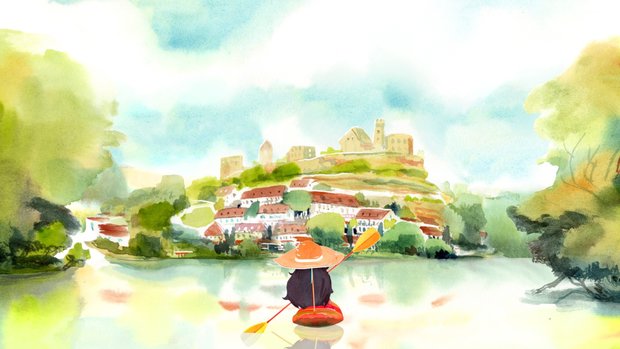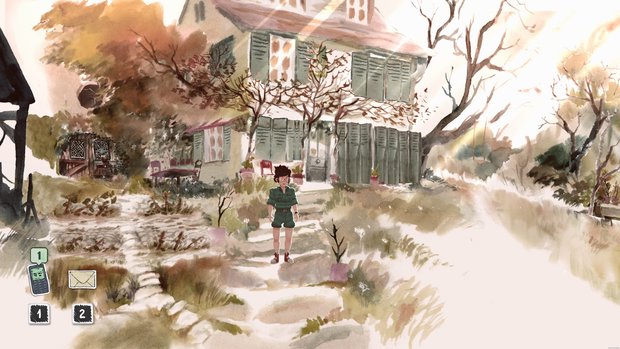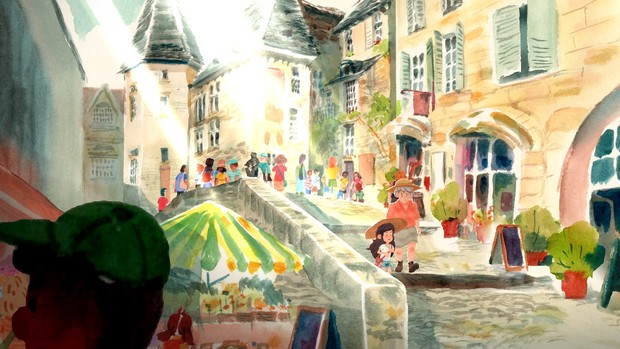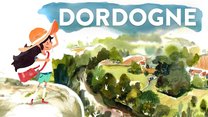Dordogne review

- 1 Comment
Light on challenge but stunning artwork and nostalgic childlike atmosphere are très magnifique
A hot June weekend felt like the start of summer vacation. The sunny, cloudless skies brought vivid extra color to the world. No worries, no obligations, just relaxing without a care in the world. With the great weather, I found myself in a lounge chair in my backyard, playing a similarly beautiful, leisurely game on my laptop. Dordogne transported me from my own small Flemish town to southern France, where a woman named Mimi finds herself tending to her grandmother’s belongings after her death. However, she doesn’t really remember much of her childhood, and it’s up to you as the player to help her fill in the gaps of that personal history. It isn’t a typical adventure game with lots of puzzles, but its gorgeous painterly world, rustic atmosphere and diverse gameplay kept me entertained throughout and left me feeling as warm inside as the weather outside.
This is the first game developed by French company Un je ne sais quoi in collaboration with Umanimation, and its biggest selling point is the graphical style. Each scene is a unique background hand-painted with watercolors by illustrator and game director Cédric Babouche, based on real-world locations in the titular region. And there are two hundred of them! Babouche worked on comic books and animated movies before expanding into video games; he’s even an art teacher, so he really knows his stuff. The most beautiful settings are the landscapes, from the rural surroundings of Grandma’s house, across the meandering Dordogne river, past a trail-rich mountain to the picturesque town further down the valley, but the indoor scenes are also designed in this same lovely style. The entire game breathes like a painting or storybook come to life.
Dordogne’s scenes aren’t completely static, as the camera slowly bobs up and down and swerves from left to right just a tiny bit at the edges even when Mimi isn’t moving, but it always focuses on her when she does. This effect only becomes apparent when you start paying attention to it, but it really helps you feel like you’re actually there, watching through an invisible observer’s eyes. Objects and persons of interest are more sharply outlined and have a glowing/flowing effect to make them stand out as hotspots. But even though you might recognize them visually in this way, some of them can’t be clicked on until they become active later on in the storyline when it’s actually time to use them. No collecting tons of inventory items without a clue how to use them in this game!

Mimi, the main character, is designed like a mix of Studio Ghibli anime and a typical 80s French style reminiscent of Albert Barillé’s animated series Once Upon a Time…. Her present-day 32-year-old self has round red glasses, unruly black hair, a green shirt and shorts, and red All Stars. But as she begins to reflect on her life, Mimi’s 12-year-old self looks a bit like a young female Indiana Jones, with a straw hat and a carrier bag. Younger Mimi is a temperamental child, constantly on the border between innocent excitement and teenage boredom. The game alternates between these two versions, the adult in 2002 and the kid in 1982. There’s a good balance between the two – even though technically speaking you probably spend more time playing with young Mimi – with each clue found in the future triggering a flashback into the past, taking you on a journey of discovery told in eight chapters.
The scenes are further brought to life with a soundtrack by Supernaive, consisting of the brothers Lucas and Baptiste Malgoire. The music adds fitting accompaniment to the various scenes you encounter, all in an 80s style. It’s a combination of New Wave sounds, fast synthesizers as if from retro video games, tracks that seem to come straight out of TV shows like Stranger Things (though rest assured there’s nothing supernatural about Dordogne), and weird-sounding pieces as if someone is constantly manipulating the whammy bar, but most of all a delightful collection of those “sounds of nature” music CDs that give everything a suitably gentle, serene vibe. It sounds like an odd mix, but it works because it combines the calm atmosphere of the pastoral Dordogne region with the energy of young Mimi and adult Mimi trying to unravel the circumstances of her life.
I played the game voiced and subtitled in English, but you can choose from several other languages if you wish. This is often the case with adventure games, only this time you can even choose Occitan, the official language of southern France, the region where the story takes place. The voice-overs are limited to the cutscenes, however, leaving the regular dialogues text-only. The characters sound very authentic, with the quality of a professional animated movie for the most part. The voice actor for young and adult Mimi is the same, and usually she succeeds in portraying the right age, but in some flashbacks it wasn’t always obvious to me that it was the adult Mimi doing the reminiscing narration. You have to click away dialogue boxes once read, but be careful not to click too fast, since it’s possible to accidentally make the text disappear before it has completely rolled out, making you miss the end of several sentences.

As adult Mimi in the present day, you collect letters involving your grandparents in which more history is explained. In Grandma Nora’s first letter, there’s mention of a special box Mimi needs to find, holding mementos of her childhood. This box is the ultimate goal, and finding it promises to bring Mimi the peace of mind she’s looking for. But first you need to access several locations in and around the house where the flashback scenes have occurred. In these scenes, playing as young Mimi, you try to make the best of your stay in Dordogne, following Grandma’s lead at first when it comes to summer activities, but later on going your own way when you meet a local boy and attempt to become friends.
You control Mimi directly instead of pointing with the mouse to the spot where you want her to go. On a keyboard the default controls are WASD, but Dordogne allows remapping; if you prefer, you can also play with a gamepad. Once you draw near to something interesting, it flashes up as a hotspot, the cursor will appear and you can use the mouse to click on it. Most often you’ll get a close-up of the area in question from a first-person viewpoint, and that’s when the regular mouse cursor appears, usually in the form of a grabbing hand.
In these close-ups, the game plays not only as a point-and-click but as a click-and-drag. You have to manipulate objects by clicking on them and holding down, then dragging or rotating them in the necessary direction, such as to turn keys and open doors. Sometimes it feels there’s one step too many in the necessary actions you have to perform, e.g. putting the key in the lock, turning the key, turning the handle, then pushing the door further open. In the first part of the game, it makes sense for there to be lots of handholding in the form of visual cues that work as a tutorial to show all the different actions you can perform. But these prompts remain present all the way until the end of the game, as if it doesn’t believe in the player’s ability to figure it out for themselves.
Then there are other interactions that weren’t at all obvious to me and actually could have used a bit more explanation. There’s a very finicky toothbrushing scene that I played with the mouse, where the left button controls the brush and the right button controls the tube of toothpaste. You have to move both around to put the toothpaste on the brush, but it felt very awkward doing so, especially because I couldn’t make much sense of the on-screen prompts.

But this scene is a great example of the plethora of activities you’re asked to perform here, most of them a lot more fun than brushing your teeth: kayaking, cooking, diving, running around a marketplace with a shopping list, and even some platformer-type scenes where you have to hike a mountain, or explore a cave system, climbing and jumping and swinging your way from point A to point B. But no worries, it’s very basic stuff and you can’t die.
There are other interesting interface elements as well. Adult Mimi carries a cellphone, with a memo app that works as a task list to keep track of your goals. She also exchanges text messages with her dad, friends and colleagues, for which you can choose the replies. The cellphone even has that very recognizable radio interference sound effect where nearby radios start to rhythmically buzz and tick whenever a text message is on its way.
The younger Mimi acquires a binder with a map of the area and a similar task list like in the older Mimi’s cellphone. As young Mimi you can choose to perform those tasks immediately, or you can explore first and thus discover hidden collectibles in the form of stickers, audio tapes, and floating words that describe her state of mind at those moments. You also get access to a Polaroid camera for taking photos of the environment, but only at designated times like key scenes in the storyline, or when you’ve discovered a beautiful vista overlooking the valley. You’ll find a tape recorder as well that you can use to capture different sounds of nature, but again only at those same particular locations. All of the gadgets you acquire are accessed through their designated buttons or keys, and their availability is always shown in the bottom left corner of the screen.
All these different collectibles can be combined into a collage at the end of each day you play as young Mimi, describing that day in a kind of scrapbook fashion. You can decide for yourself how Mimi feels about that day by creating a small poem inspired by the floating words you have found. These poems can be happy or sad, depending on what you choose. But whichever direction you go, it won’t change anything in the storyline. It’s only there to express your own feelings about what’s going on, or at least how you imagine Mimi might be feeling.
While there are many different objectives to fulfill, in essence they don’t amount to much more than go there, or get this. There isn’t much real puzzling here. It’s all about the experience, not only of being in this world, but also of being Mimi, and doing Mimi-like things. There’s only one real puzzle, consisting of locating a hidden place on a map, but even it doesn’t amount to much. You have to put stickered drawings on their right place on the map, then connect the right ones based on written clues, and then it’s X marks the spot. This makes the game very accessible to a younger audience. It even looks a lot like an animated movie, but without appearing too childish to scare away more mature players.
Dordogne lacks a manual save system, but the autosave is one of the most efficient I’ve ever encountered. It records your progress after pretty much everything you do, and when you reload, the game repeats the last bit of dialogue Mimi delivered – very handy when there’s a significant gap between playing sessions. However, a manual save or even a level select option would’ve been welcome to go back to a previous chapter and hunt for the collectibles you missed the first time around. You can see what you’re missing from the empty slots in your scrapbook, but they can only be found in their respective chapters.
While the majority of the journey is all fun and games, without spoiling anything, the ending is more on the dramatic side. There’s even an impressive underwater scene that reminded me of Close Encounters of the Third Kind (without the aliens) but I missed a more interactive element here; it could’ve made for a cool music- and color-related puzzle instead.
Final Verdict
Running around in Dordogne for five or so hours (even more if you want to hunt after every collectible) will make you feel like a little kid again, without a worry in the world, just having fun with whatever is at your disposal. A lack of puzzles will be an issue for some, but there’s gorgeous scenery to enjoy, filled with beautiful music and sounds of nature, and lots of gameplay tasks to keep you busy in a variety of different ways. The controls could’ve used some fine-tuning, and the more basic pop-up instructions could’ve been dropped after a suitable tutorial period. But the game ends with plenty of excitement, and might even make you shed a tear when you connect all the dots at its conclusion. Add it all up and it’s like its own perfect little vacation to put aside adult responsibilities and ease a weary mind.
Hot take
Dordogne takes you on a stunning watercolor journey through the past and present of rural southern France. There isn’t anything much in the way of challenge, but it’s a charming interactive storybook that will remind you of the really important things in life.
Pros
- Two hundred different gorgeous watercolor backgrounds
- You can roleplay the main character’s personality to your own taste
- Lots of gameplay variety
- Very efficient autosave function
Cons
- Some controls come with too much handholding, while others could use more guidance
- Player choices don’t impact the storyline
- Lack of a manual save makes it impossible to revisit earlier chapters
Johnny played Dordogne on PC using a review code provided by the game's publisher.










1 Comment
Want to join the discussion? Leave a comment as guest, sign in or register.
French guy from the south of France, Occitan is NOT the official language of anywhere, it's considered a dead language, it WAS a south france language at some point, but not anymore, do better research
Reply
Leave a comment